Han Chao Chang1, Kuo Cheng Huang1, Hsin Yi Tsai1, Shen Cheng Chiu2
1Instrument Technology Research Center, National Applied Research Laboratories, Taiwan
2Implant Centre, Beethoven Dental Clinic, Taiwan
Correspondence to: Hsin Yi Tsai, Instrument Technology Research Center, National Applied Research Laboratories, Taiwan.
| Email: |  |
Copyright © 2012 Scientific & Academic Publishing. All Rights Reserved.
Abstract
A shadowless lamp is usually applied to medical and surgical operation to reduce the shadow effect of human head/hand or the other obstacle located in the light propagation direction, which comprises of a specific shape reflector and a lampwick. Different from the design of tradition shadowless lamp, we proposed a lemon-like shadowless lamp for dental application to enhance the luminous intensity of four corners within the oral cavity. In practices, the lamp design can reduce the shadow from objects and extend the visible area in the molars, and it still can meet the requirements of luminance level and illumination area in the ISO-9680:2007 lighting standard. In addition, the illumination area was also adjusted by rotating slightly the symmetry reflector of lemon-like lamp and shifting the position of its lampwick. Furthermore, the finite element method was used to confirm that there is little thermal deformation on the symmetry reflectors.
Keywords:
Lemon-like, Shadowless, Molars, ISO-9680:2007
Cite this paper: Han Chao Chang, Kuo Cheng Huang, Hsin Yi Tsai, Shen Cheng Chiu, A Lemon-like Shadowless Lamp for Dental Use, International Journal of Instrumentation Science, Vol. 2 No. A, 2013, pp. 15-19. doi: 10.5923/s.instrument.201306.03.
1. Introduction
The reflective lamp has been utilized in dental lighting for over 30 years. The visible light reflected by its free-form reflectors can focus the light into the oral cavity and avoid the light directly shining into patient’s eyes[1]. Even so, there are a small number of academic studies specializing in this particular subject, but only a few inventive patents[2-3] which afforded design techniques and solutions relating to shadowless surgical lamps for commercial implementation. Corning Glass Works[2] formulated a remarkable and conjugated focus reflector which based on an ellipsoid surface with several sections. Furthermore, the center point of the ellipsoidal substrate was used as the benchmark in this patent, and the internal surface of the reflector had been segmented into bilateral symmetry sections and each section was rotated, spun outward and sequentially adjusted towards a conjugate focus on the major axis (see Fig. 2). Consequently, a shadowless beam pattern was generated for the oral cavity width. This design would definitely fulfill the requirement of the ISO 9680:2007 standard[4] with an illumination area of 50 mm on the horizontal axis and 25 mm on the vertical axis (Fig.1). In addition, the luminance of illuminated area is about 18,000-22,000 lux in general clinic. However, the position of the bulb holder would be concerned in this specific pattern. This could either frustratingly intercept the light projecting effect or perhaps produce a shadow over the horizontal axis of working plane. In general, it means that the shadowless beam pattern may be shadowed by the bulb holder and consequently may cause insufficient luminance in the vertical direction. As a result, the clinical dentist needs to frequently adjust the position of this dental lamp to remove the shadows, particularly at the molars area, to obtain more clearly visible images.Moreover, Chuang’s design[3] was mainly to adjust the direction of irradiation light to attenuate the shadows generated by the interposition between the light rays and the operating field. He highlighted that the internal surface of the reflector is shaped from several sets of two diverse free-form curves and which rotate 360° to encircle the center of the reflector. It means that the reflector can be equiangular split into plurality minor parts in both vertical and horizontal direction (Fig. 2). This technique provides an important partial light projecting effect at the described region that will weaken the shadows caused by the clinician’s hands and operating instruments. Even though this layout would likely satisfy the basic requirements of the ISO 9680:2007 standard[4] since the dimensions of the shadow should be less than 12 mm, but it may overly concentrate on the inner area of the illumination region (Fig. 4) and cause the patient to feel hot and uncomfortable.From the above studies, we found the shadowless light source often consists of an ellipsoidal or parabolic reflector and a halogen lamp coupled with a bulb holder. The structural function of the light source is to generate a cylindrical illumination region and illuminate the certain operating field sequentially. But the traditional design often generate a shadow operating field when several light rays are partially intercepted by the clinician's head or hands and instruments[5]. In addition, we noticed that the dentist’s head was not a major interference because the operating light is positioned at the upper inclined part of the dentist’s head rather than at the dentist’s fingers or instruments (Fig. 4). In order to improve these problems and disadvantages, a new lemon-like shadowless design was developed in this study.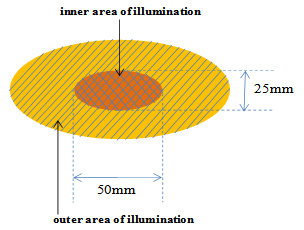 | Figure 1. Requirement of illumination areas in ISO 9680:2007 |
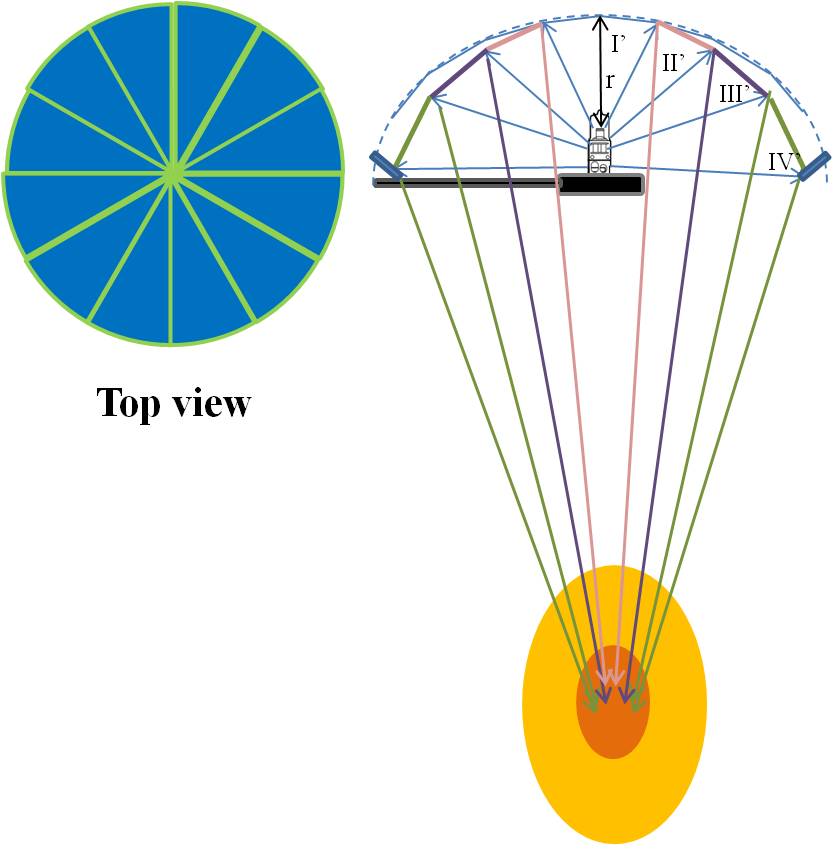 | Figure 2. Ray paths from US patent 4,149,227 design |
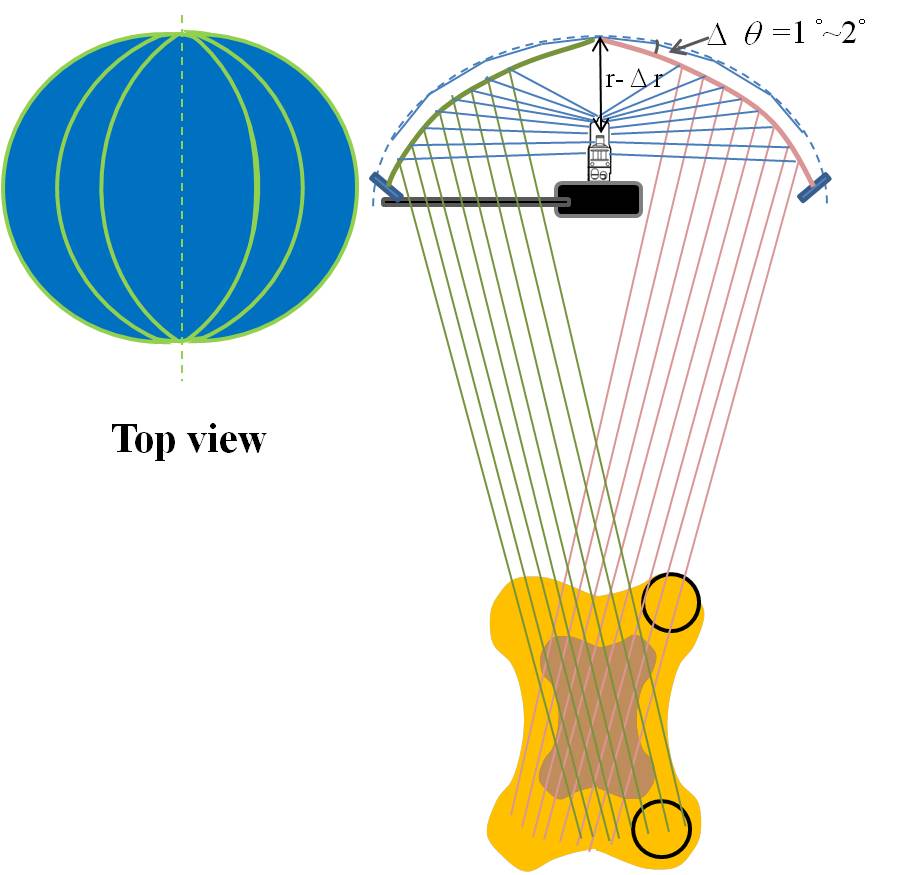 | Figure 3. Ideally ray paths of this study |
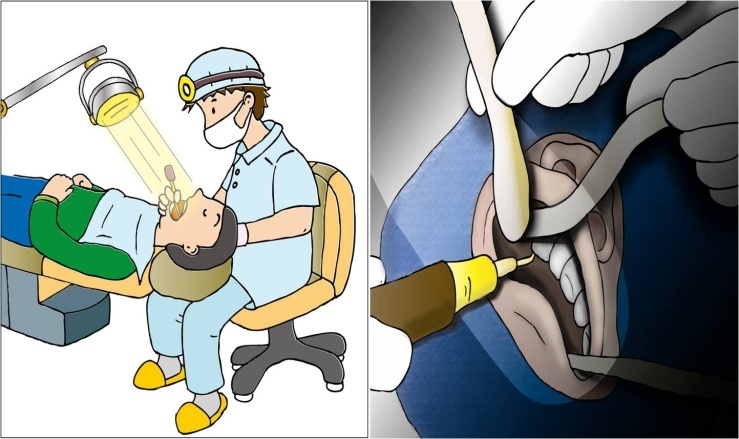 | Figure 4. Positions of dental light, dentist’s head and hand, instrument in operating field |
2. Lemon-Like Reflector Design
Based on the design of ellipsoidal reflector, we designs a sample pair of the bilateral symmetry curve (lemon-like) along the inner surface of the reflector to simulate the light projecting effect, illumination area and luminance relating to the working plane, shown in Fig. 3. These ellipsoidal segments can be rotated by an appropriate angle to acquire the optimal shadowless images, which are simulated by the Apilux® optical-mechanical software. Theoretically, the aspheric surfaces are normally described mathematically in varied styles[6], and an general aspheric surface are frequently expressed as the following formula,  | (1) |
where the z(r) is the perpendicular z-component displacement of the surface from the vertex at distance r from the axis, shown in Fig.5. Where r is the radius of curvature, R0 is the curvature radius at vertex, k is the conic constant. The coefficients αi is referred to the deviation of the surface from the axially symmetric quadric surface specified by r and k. Therein, the form of surface is generated by the conic section rotated about the optic axis, and which is characterized by -1 < k < 0 for this ellipsoidal reflector.  | Figure 5. Schematic of the z(r) displacement with different curvature radius r |
3. Results
In the study, a regular halogen bulb (Osram-64151) designed was employed for the analysis and simulation of lemon-like shadowless dental lamp. The lumen (lm) of halogen bulb is 1,450 lm /watt and the filament has a C6 pattern. In addition, three primary parameters must be determined during optical simulation: (1) Power, the lumens of the halogen bulb is associated with the power. (2) Spectrum, the spectrum of reflected light was filtered out the region of IR and UV section (i.e. 450 ~ 650 nm) (3) Working distance, the working distance between the lampwick and the working plane is required to follow the ISO 9680:2007 standard at a perpendicular distance of 700 mm. 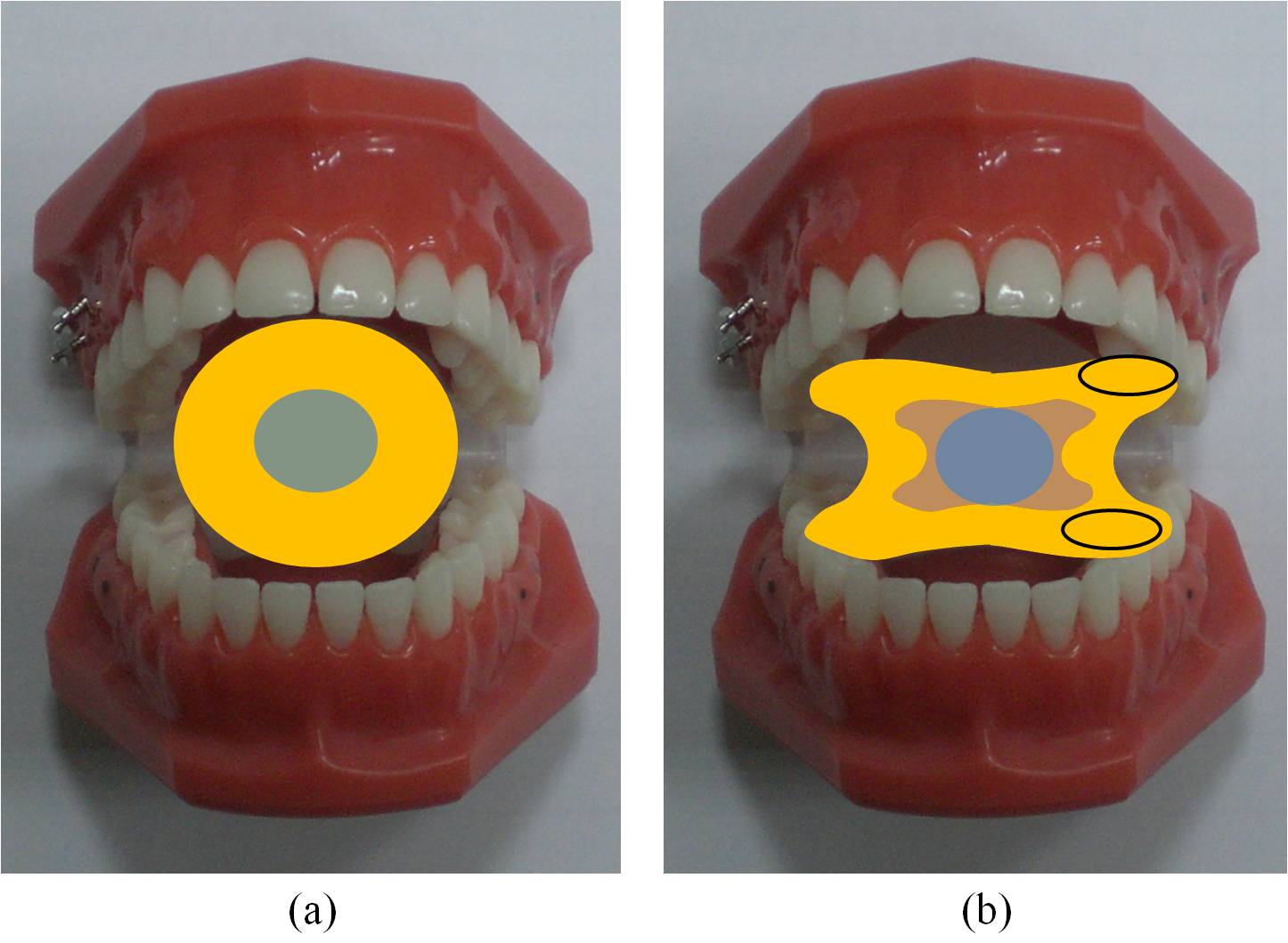 | Figure 6. Illuminated area in oral cavity with design of US patent 4,149,227 and this study |
Moreover, we adopted the conic constant k between 1 and 0 for an initial simulation to obtain the optimal rotated and balanced angle for each single section of the bilateral symmetry curve. This initial simulation was expected to enhance the light projecting effect on the working plane, improve the illumination area at the vertical axis, and weaken the shadow located at the molar areas. After that, we found that when the lampwick and its holder were fastened at the distance with the radius of curvature r, the light projecting effect was similar to the light rays[2] was still focused on the inner area, shown in Fig. 6a. For this reason, we considered a new shadowless design and the conic constant was modified slightly between -0.9 and -1.0, then the position of the lampwick and its holder was shifted from r to r-Δr, which assuming Δr was equal to r/1,000 - r/10 to further improve the initial simulation result, shown in Fig.6b.In practice, the non-uniform thermal effect would induce the deformation of reflector and the wavefront aberration of optical system. Therefore, an optical-mechanical simulation by the finite element method (FEM)[7] is needed to verify the thermal deformation of the designed reflector.
4. Discussion
This results of shadowless simulation showed that the optimal rotated and balanced angle for each section of the bilateral symmetry curve is about 1-2 degrees, and it consequently formed a lemon-like reflector (see Fig. 3). When observing the luminance distribution of lemon-like shadowless design (see Figs. 7 and 8), we found the luminance of the illuminated inner area was approach 60,000-65,000 lux, and it was very uniform and higher than that of Corning Glass Works[2], shown in Table 1. However, the luminance at a distance of 60 mm was only slightly greater than 1,200 lux, shown in Fig. 9. Table 1. Luminance of the illuminated inner area
 |
| |
|
Finally, when the thermal deformation of the designed reflector was verified by the FEM, we found the mirror reflectance was approach 95% when the same regular halogen bulb (Osram-64151) was employed. In the simulation, we assume that the four edges of reflector had been fixed, shown in Fig.10. The FEM simulation results of reflector deformation are shown in Fig.11, and the maximum thermal deformation was calculated about 0.2691 um. Therefore, the results indicated that the main thermal deformation was astigmatism aberration; the magnitude was too small to affect the illumination of lemon-like lamp. Therein, only little thermal deformation occurred in the dental light system.  | Figure 7. Rays path simulation from lemon-like reflector to working plane |
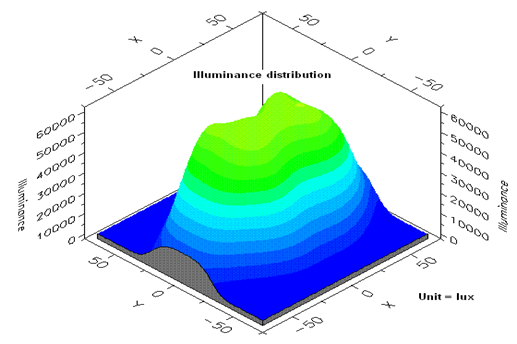 | Figure 8. Illuminance distribution of this study |
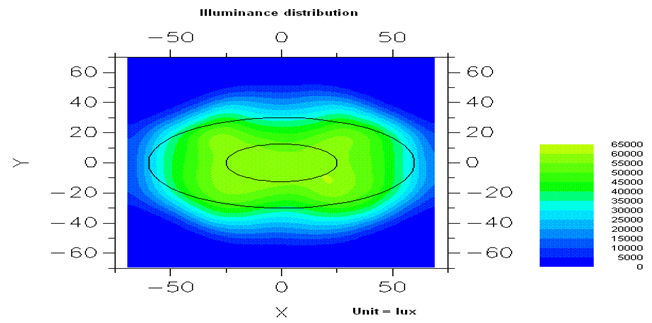 | Figure 9. Stereoscopic effect of illuminance distribution |
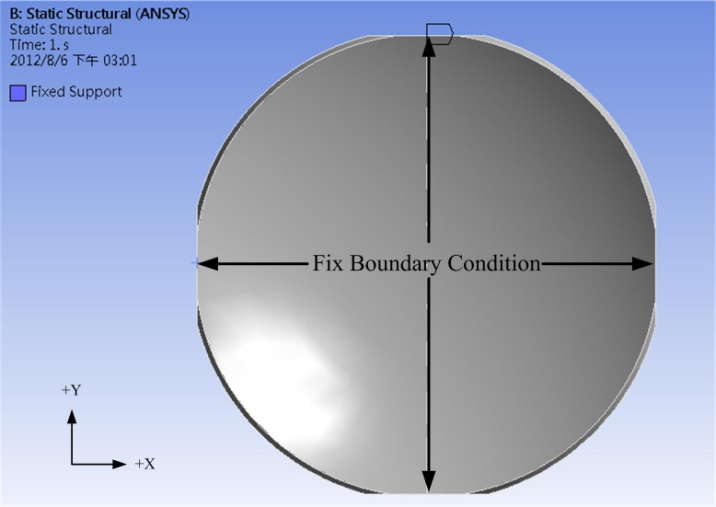 | Figure 10. The FEM simulation boundary |
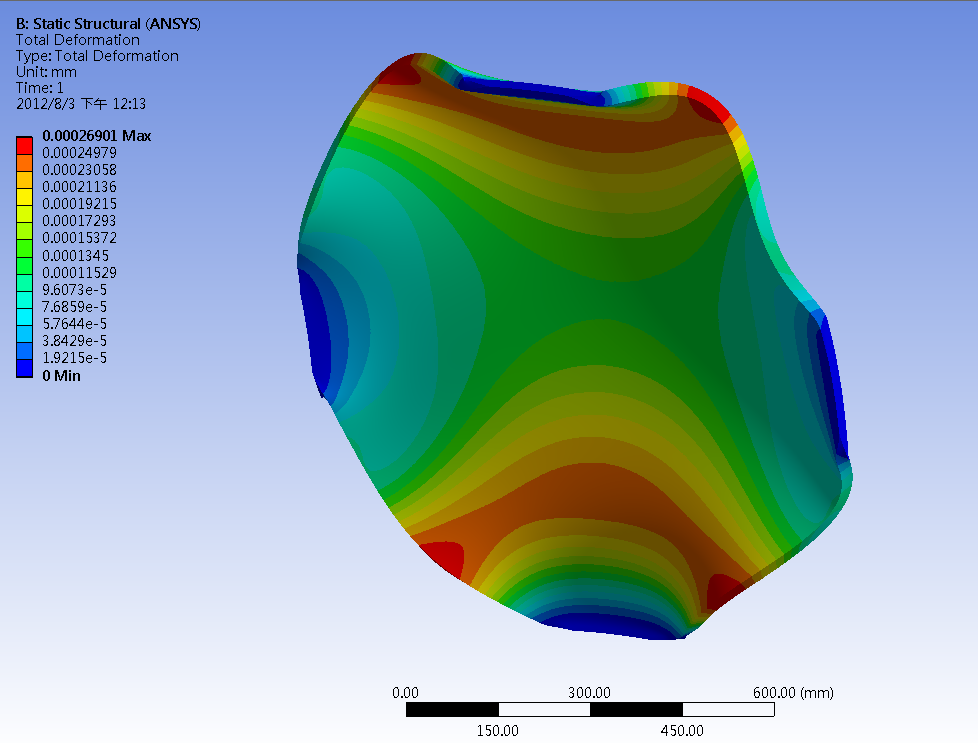 | Figure 11. The results of mirror deformation |
5. Conclusions
In this study, we designed a lemon-like lamp with a pair of reflectors of bilateral inner symmetry surface to develop a shadowless lighting technology for dental use, which was based the ellipsoidal surface. In addition, we modified the conic constant slightly to -0. 9 < k < -1, then the position of lampwick and its holder was shifted from r to r-Δr. Therein, the Δr was assumed to be r/1,000-r/10 in the simulation. From the results, we found the new optical-mechanical design not only can produce a shadowless light but also can meet the requirements of luminance and illumination areas in the ISO 9680:2007 standard. Finally, the illuminated area of four corners were increased, and which formed a butterfly spot size overall. The lemon-like shadowless lamp would eliminate the shadows located at the molar areas and enhance the luminance on the four corners in the oral cavity.
ACKNOWLEDGMENTS
The authors are grateful for the research support from the National Science Council of Taiwan, R.O.C. under grant number NSC 101-2622-B-492-001-CC3.
References
| [1] | B. Yang, Y. Wang, Y. Liu, J. Sasian, and J. Koshel, "Efficient ray-tracing for free-form reflectors," Optik-International Journal for Light and Electron Optics 120, 40-44 (2009). |
| [2] | W. H. Dorman, "Reflector," U. P. Office, ed. (Corning Glass Works, USA, 1979). |
| [3] | Y. F. Chuang, "Profiles of shadowless reflector for operating lighting," U. Patent, ed. (2000). |
| [4] | ISO, "9680:2007 Dentistry-Operating lights," (Switzerland, 2007). |
| [5] | C. S. Miller, F. M. Leonelli, and E. Latham, "Selective interference with pacemaker activity by electrical dental devices," Oral Surgery, Oral Medicine, Oral Pathology, Oral Radiology and Endodontology 85, 33-36 (1998). |
| [6] | Y. S. Kim, K. B. Ahn, K. J. Park, I. K. Moon, and H. S. Yang, "Accuracy Assessment for Measuring Surface Figures of Large Aspheric Mirrors " Journal of the Optical Society of Koera 13, 178-183 (2009). |
| [7] | H. G. Rhee, H. S. Yang, I. K. Moon, H. Y. Kihm, J. H. Lee, and Y. W. Lee, "Eight-axis-polishing Machine for Large Off-axis Aspheric Optics," Journal of the Optical Society of Koera 15, 394-397 (2011). |













 Abstract
Abstract Reference
Reference Full-Text PDF
Full-Text PDF Full-text HTML
Full-text HTML